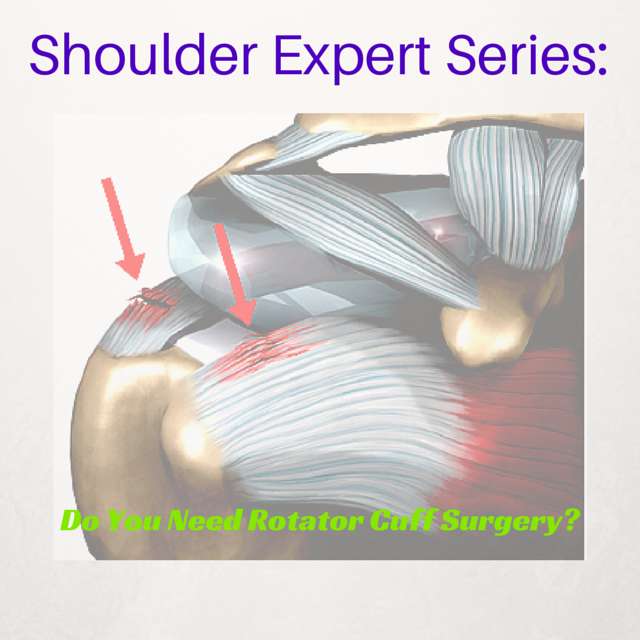ou have been told you need rotator cuff surgery. Do you?
Degenerative rotator cuff tears are very common. Many small degenerative rotator cuff tears will not require surgery. After 40, many people will have a rotator cuff tear and not even know it. You may wish to review our first Expert Series post where we covered the cause of rotator cuff tears.
Remember:
The rotator cuff is the most likely source of pain a犀利士
fter 30
Most rotator cuff issues, including tears are due to degeneration or attrition
Most patients with small degenerative rotator cuff tears can be treated without surgery.
Surgery for degenerative rotator cuff tears is generally considered after failure of a non-surgical regimen of physical therapy, possible injections and oral medications.
As accomplished shoulder surgeons, when do we consider surgery for a small degenerative rotator cuff tear?
Our Expert Series continues today with an answer to your question:
Do I Need Rotator Cuff Surgery ?
Derek Ochiai, MD: Website, Twitter
Surgery is an option for degenerative rotator cuff tears that fail to respond adequately to non-surgical treatment, such as physical therapy and cortisone injections. Also, the rotator cuff tear is inhibiting the patient’s quality of life.
Scott Slattery, MD: Website, Twitter
There are many options for the treatment of a small degenerative rotator cuff tear. I give all patients with small degenerative tears the option to treat them non-surgically with anti-inflammatory medications as well as physical therapy to improve flexibility, strength, muscle balance and coordination. This can work quite well. If the patient has good function and minimal pain, surgery is not absolutely required. If the tear is degenerative, chronic and large with associated muscle atrophy, initial non-surgical treatment with oral medications, injections and physical therapy is almost always the best option.
Marty Leland, MD: Website, Twitter, Facebook
When I first see a patient over 40 with shoulder pain, my first treatment is anti-inflammatories, physical therapy, and frequently a subacromial steroid injection. I will then see the patients back 6-8 weeks later. If they are much better, there is no need for any further treatment. If they aren’t much better, I get an MRI to evaluate their rotator cuff. I usually do not order an MRI the first time I see them because, even if they do have a small rotator cuff tear, I would like to see if non-operative treatment would help them. If it does, GREAT! They may have avoided a surgery. I only order MRIs if they aren’t getting better. However, if I have a patient with a long history of shoulder pain and weakness and they are very weak on examination, I sometimes do order an MRI after the first office visit.
Jeffery Berg, MD: Website, Twitter
Degenerative rotator cuff tears are extremely common. Often these tears can be asymptomatic and incidentally diagnosed. So the first component of my “treatment” for these tears is to determine if they are symptomatic or not. If not felt to be symptomatic, I direct my treatment towards the suspected source of the patient’s symptoms and I advise observation of the tear. The observation primarily consists of clinical evaluations (history and exam) yearly if they remain asymptomatic or sooner if symptoms worsen, since these tears can progress and that progression usually is associated with an increase in symptoms. Depending on the office evaluation, I might also suggest serial ultrasounds or MRIs to evaluate for progression.
If these tears are felt to be symptomatic, I typically will start with nonoperative treatment. I find this to be the most reasonable treatment as degenerative tears often respond favorably to “conservative care” and although the symptoms can often respond well to surgery, they often don’t fully heal following the surgery. My nonoperative treatment consists of oral anti-inflammatories to treat the frequently associated bursitis as well as the pain that often brings the patient to the office. I will almost always include physical therapy as there usually is associated shoulder dysfunction and finally I suggest avoiding aggravating activities. Typically, I try this for 4-6 weeks, looking for any improvement. If improvement is seen, I will suggest continued nonoperative treatment until symptoms resolve or stabilize at an unacceptable level. If the latter, I will recommend an arthroscopic repair. If there is some retraction (lateral to mid humeral head) seen on the MRI, and depending on some specific patient characteristics (ie. young health, high activity level, etc.), I may suggest surgery on initial diagnosis, as I am concerned that if there is any further retraction, the tear may become unrepairable.
How we as physicians manage certain injuries may not always seem logical to patients. Many will not understand why we do not MRI every painful joint and many do not understand why we do not need to operate on everything that is “torn”. It is our obligation to educate you.
Our last post … When Should We MRI Your Shoulder will help you understand that we can make a reasonably good diagnosis and establish a treatment plan that should work without expensive, time consuming imaging. In addition, many of our parts wear out. Like your favorite pair of jeans … Not all rotator cuff tears need to be fixed. The American Academy of Orthopedic Surgeons produced a document to assist surgeons in evidence based management of rotator cuff tears. In this document, they find limited evidence to support surgery for degenerative rotator cuff tears without a trial of non-surgical management. That said, some rotator cuff tears might continue to hurt after non-surgical treatments … and you might be offered surgery as an option to improve your pain and thus your quality of life.



